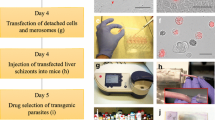Abstract
The rat parasite Eimeria nieschulzi is a suitable model for transfection studies and was used as an additional model organism for the genus Eimeria. We describe the transfection of this apicomplexan parasites and the cultivation of transformed stages in cell culture and in vivo. The β-galactosidase or yellow fluorescent protein was expressed in all parasitic stages up to the second merozoite generation in vitro under control of the heterologous promoter region of Eimeria tenella mic1 gene previously described for E. tenella transfection. Pyrimethamine resistant E. nieschulzi parasites were obtained in vitro after transfection with a plasmid encoding the Toxoplasma gondii dhfr/ts-m2m3 gene. Co-transfection experiments with an YFP-plasmid resulted in pyrimethamine resistant and fluorescent parasitic stages. Infection of rats with transfected E. nieschulzi sporozoites directed to expression of β-galactosidase or YFP in oocysts. Co-transfection with YFP/DHFR-TS allowed selection of resistant parasites in vivo. Excreted transgenic oocysts showed arrangement of YFP expression which lead to questions about meiotic recombination frequency and mechanisms.








Similar content being viewed by others
Notes
Kindly provided by Julie Clark and Fiona Tomley (submitted)
Kindly provided by Julie Clark and Fiona Tomley (submitted)
References
Black M, Seeber F, Soldati D, Kim K, Boothroyd JC (1995) Restriction enzyme-mediated integration elevates transformation frequency and enables co transfection of Toxoplasma gondii. Mol Biochem Parasitol 74(1):55–63
Coudert P, Licois D, Drouet-Viard F (1995) In: Eckert J, Brown R, Shirley MW (eds) Cost 89/820 Biotechnology: guidelines on techniques in coccidiosis research. European Comission, Luxembourg, p 61
del Cacho E, Pages M, Gallego M, Monteagudo L, Sanchez-Acedo C (2005) Synaptonemal complex karyotype of Eimeria tenella. Int J Parasitol 35(13):1445–1451
Donald RG, Roos DS (1993) Stable molecular transformation of Toxoplasma gondii: a selectable dihydrofolate reductase-thymidylate synthase marker based on drug-resistance mutations in malaria. Proc Natl Acad Sci U S A 90(24):11703–11707
Gubbels MJ, Li C, Striepen B (2003) High-throughput growth assay for Toxoplasma gondii using yellow fluorescent protein. Antimicrob Agents Chemother 47(1):309–316
Hao L, Liu X, Zhou X, Li J, Suo X (2007) Transient transfection of Eimeria tenella using yellow or red fluorescent protein as a marker. Mol Biochem Parasitol. 153(2):213–215
Hinterberg K, Mattei D, Wellems TE, Scherf A (1994) Interchromosomal exchange of a large subtelomeric segment in a Plasmodium falciparum cross. EMBO J 13(17):4174–4180
Hnida JA, Duszynski DW (1999) Taxonomy and phylogeny of some Eimeria (Apicomplexa:Eimeriidae) species of rodents as determined by polymerase chain reaction/restriction-fragment-length polymorphism analysis of 18S rDNA. Parasitol Res 85(11):887–894
Hofmann J, Raether W (1990) Improved techniques for the in vitro cultivation of Eimeria tenella in primary chick kidney cells. Parasitol 76(6):479–486
Jeffers TK (1976) Genetic recombination of precociousness and anticoccidial drug resistance in Eimeria tenella. Z Parasitenkd 50(3):251–255
Kelleher M, Tomley FM (1998) Transient expression of beta-galactosidase in differentiating sporozoites of Eimeria tenella. Mol Biochem Parasitol 97(1–2):21–31
Kurth M, Entzeroth R (2008) Improved excystation protocol for Eimeria nieschulzi (Apikomplexa, Coccidia). Parasitol Res 102(4):819–822
Matrajt M, Nishi M, Fraunholz MJ, Peter O, Roos DS (2002) Amino-terminal control of transgenic protein expression levels in Toxoplasma gondii. Mol Biochem Parasitol 120(2):285–289
Pfefferkorn LC, Pfefferkorn ER (1980) Toxoplasma gondii: genetic recombination between drug resistant mutants. Exp Parasitol 50(3):305–316
Relman DA, Schmidt TM, Gajadhar A, Sogin M, Cross J, Yoder K, Sethabutr O, Echeverria P (1996) Molecular phylogenetic analysis of Cyclospora, the human intestinal pathogen, suggests that it is closely related to Eimeria species. J Infect Dis 173(2):440–445
Rick B, Dubremetz JF, Entzeroth R (1998) A merozoite-specific 22-kDa rhoptry protein of the coccidium Eimeria nieschulzi (Sporozoa, Coccidia) is exocytosed in the parasitophorous vacuole upon host cell invasion. Parasitol Res 84:291–296
Schmatz DM, Crane MS, Murray PK (1984) Purification of Eimeria sporozoites by DE-52 anion exchange chromatography. J Protozool 31(1):181–183
Sheather AL (1923) The detection of intestinal protozoa and mange parasites by a flotation technique. J Comp Pathol 36:266–275
Shirley MW, Ivens A, Gruber A et al (2004) The Eimeria genome projects: a sequence of events. Trends Parasitol 20:199–201
Su X, Ferdig MT, Huang Y, Huynh CQ, Liu A, You J, Wootton JC, Wellems TE (1999) A genetic map and recombination parameters of the human malaria parasite Plasmodium falciparum.
van den Hoff MJ, Moorman AF, Lamers WH (1992) Electroporation in ‘intracellular’ buffer increases cell survival. Nucleic Acids Res 20(11):2902
Wagner WH, Foerster O (1967) The first stages of the development of E. acervulina (Coccidia) in experimentally infected chicks. Z Parasitenkd 28(3):232–239
Zhao X, Duszynski DW, Loker ES (2001) A simple method of DNA extraction for Eimeria species. J Microbiol Methods 44(2):131–137
Acknowledgements
We appreciate and thank for financial support from the German Research Foundation (DFG). Grateful thanks go to Fiona Tomley and Julie Clark (Institute for Animal Health, Compton, UK) providing us with the plasmids and for the great support and successful collaboration. In this combination we thank the European Union for financing a research visit during the COST857 program. Many thanks go to Boris Striepen (University of Georgia, Athens, GA, USA) and Marc-Jan Gubbels (now Boston College, USA) for providing lab capacities and mentoring during a DFG founded research period. We also thank Bill Chobotar (Andrews University, USA) for reading and correcting the manuscript.
Declaration
We declare that the experiments comply with the current laws of Germany where they were performed.
Author information
Authors and Affiliations
Corresponding author
Rights and permissions
About this article
Cite this article
Kurth, M., Entzeroth, R. Reporter gene expression in cell culture stages and oocysts of Eimeria nieschulzi (Coccidia, Apicomplexa). Parasitol Res 104, 303–310 (2009). https://doi.org/10.1007/s00436-008-1192-0
Received:
Accepted:
Published:
Issue Date:
DOI: https://doi.org/10.1007/s00436-008-1192-0




